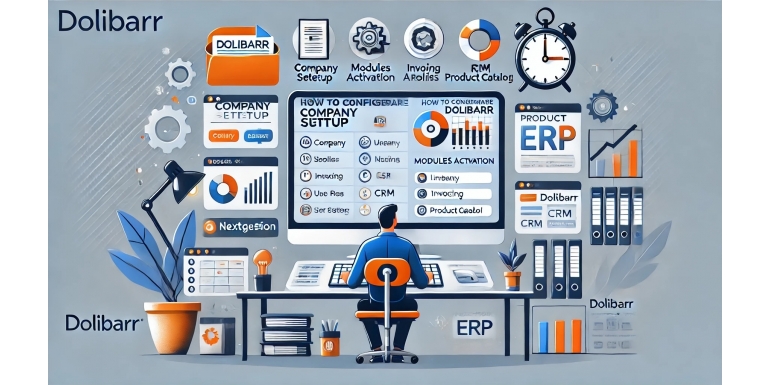
When it comes to Enterprise Resource Planning (ERP) and Customer Relationship Management (CRM) software for small businesses, Dolibarr stands out as a powerful and flexible open-source solution. Its modularity, intuitive interface, and ease of use make it ideal for entrepreneurs and small teams that need structure without complexity.
If you’ve just installed Dolibarr and are wondering how to configure it for your business quickly, this step-by-step guide will show you how to do it in under an hour. Whether you’re running a retail store, a consultancy, or a service-based company, this guide will help you tailor Dolibarr to your real-world needs.
Let’s break the process into logical steps that you can follow easily.
1. Understand the Structure: Modules Are Everything
Before diving in, it’s crucial to understand that Dolibarr is modular. This means you can activate only the features you need, keeping your system lightweight and efficient.
Key modules for small businesses:
-
Third Parties (Customers/Suppliers)
-
Products/Services
-
Invoices
-
Proposals/Quotes
-
Orders
-
Projects
-
Bank & Cash
-
Expense Reports
-
Human Resources (if you have employees)
How to activate:
Go to Home > Setup > Modules/Applications. Activate only what you need.
For most small businesses, Third Parties, Invoices, Orders, and Products will be the core.
2. Set Up Your Company Profile (10 minutes)
Navigate to Home > Setup > Company/Organization. Fill in your business’s legal name, address, phone, email, and upload your logo. These details will appear on documents like invoices and quotes.
Important fields:
-
Company name and address
-
Legal/tax identification (like VAT number)
-
Default currency
-
Fiscal year settings
Having this properly configured ensures your documents are legally compliant and branded professionally.
3. Configure Currencies, Taxes, and Languages (5 minutes)
Go to Setup > Dictionaries to set your default currency and applicable tax rates.
-
Currency: Set your operating currency (e.g., USD, EUR).
-
Tax rates: Define VAT or sales tax percentages depending on your country.
-
Languages: Choose interface languages for users and customers.
This step ensures that your transactions reflect accurate financial and legal context.
4. Add Users and Set Permissions (10 minutes)
If you’re the only user, you can skip this. But for teams, go to Users & Groups > New User and create separate accounts.
Best practices:
-
Create groups (Sales, Admin, HR, etc.)
-
Assign modules and permissions per group
-
Use strong passwords and unique usernames
Setting up user roles ensures operational security and accountability.
5. Define Products and Services (10 minutes)
Go to Products/Services > New Product to start creating what your business sells.
For each product/service:
-
Name
-
Reference code
-
Price (tax inclusive/exclusive)
-
Description
-
Type (product vs. service)
You can also define stock quantities, suppliers, or even serial numbers if needed.
For service-based businesses, focus on time packages, consulting hours, or deliverables.
6. Add Your Clients and Suppliers (10 minutes)
Under Third Parties, create entries for your clients and vendors.
Fields to include:
-
Company name or individual
-
Contact person
-
Email/phone
-
Billing and delivery addresses
-
Payment terms
The more complete your records, the easier invoicing and communication become.
If you have existing data, use the CSV import tool under Tools > Imports.
7. Customize Document Templates (5 minutes)
Go to Setup > Modules > Invoices/Quotes and choose a document template.
Things you can personalize:
-
Company logo
-
Header/footer texts
-
Font size and layout
You can preview templates before applying them. This helps your brand look consistent and professional.
8. Configure Payment Methods and Bank Accounts (5 minutes)
Head to Bank & Cash > New Account and define your company’s bank accounts.
Also, set up accepted payment methods (bank transfer, credit card, PayPal).
These will be used for invoices and financial reports.
9. Adjust Default Settings and Automation (5 minutes)
Go to Home > Setup > Other Setup to fine-tune your environment:
-
Default language
-
Timezone
-
Document numbering formats
-
Default due dates
You can also automate reminders, set default VAT behavior, and configure recurring invoices.
10. Run a Test Workflow (10 minutes)
To ensure everything works:
-
Create a sample client.
-
Add a product or service.
-
Create a proposal.
-
Convert it into an order.
-
Convert the order into an invoice.
-
Record a payment.
This full cycle helps validate your setup.
Bonus: Backup and Security Tips
You should immediately consider:
-
Enabling HTTPS if not already enabled
-
Deleting the /install folder for security
-
Setting up automatic backups using cron jobs or third-party plugins
-
Configuring SMTP email to send invoices directly from Dolibarr
A secure and backed-up ERP is a reliable ERP.
Additional Modules You Might Explore Later
Once you’re up and running, you can extend functionality with modules like:
-
POS (Point of Sale): Ideal for physical shops
-
Inventory: For detailed stock management
-
Contracts and Subscriptions: For recurring services
-
Emailing: For newsletters or client outreach
-
Dolistore Marketplace: Install third-party modules for specialized needs
Remember, Dolibarr grows with you.
Final Thoughts
You don’t need a tech team or ERP consultant to get started with Dolibarr. With just one focused hour, you can configure a fully functional business management system tailored to your small business.
The keys are:
-
Activate only the modules you need
-
Enter clean, accurate data
-
Personalize documents for your brand
-
Automate what you can to save time
Once done, you have a system that manages your clients, invoices, products, and finances in one place.
Now that you’re set up, you can focus on what really matters—growing your business.
Need help later? Dolibarr’s forums and documentation are excellent. And once you're comfortable, you can always add new modules or even integrate external tools using the Dolibarr API.
Get organized. Go fast. Grow smart—with Dolibarr.
